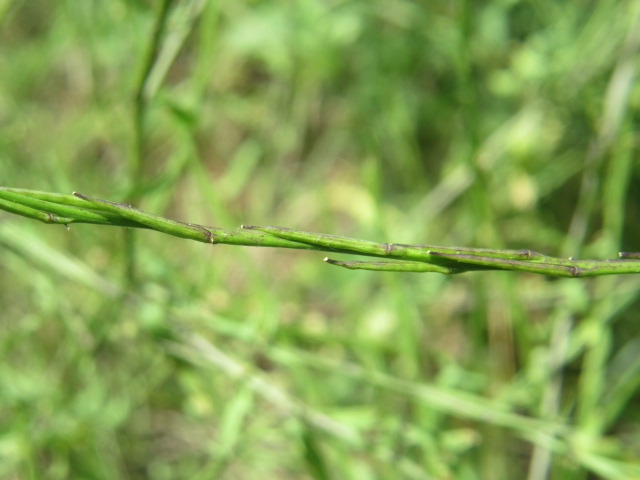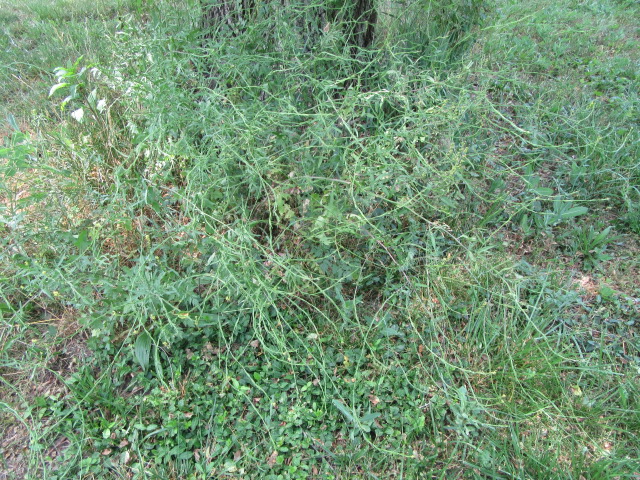
Sisymbrium officinale (Hedge Mustard) on 5-10-23, #938-31.
Hedge Mustard, Common Hedge Mustard, Bankweed, Californian Cress, Hedgeweed, Crambling Rocket, Tumbling Mustard, Oriental Mustard, Wild Mustard, Indian Hedge Mustard, Oriental Rocket, Mustard, English Water Cress, Hedge Tumble Mustard, Hairy-pod Hedge Mustard
Sisymbrium officinale
sis-SIM-bree-um of-fiss-ih-NAH-lee
Synonyms of Sisymbrium officinale (26) (Updated on 12-6-23 from Plants of the World Online): Chamaeplium officinale (L.) Wallr. (1822), Crucifera sisymbrium E.H.L.Krause (1902), Erysimum officinale L. (1753), Erysimum officinale var. leiocarpum (DC.) Farw. (1924), Erysimum runcinatum Gilib. (1782) (opus utique oppr.), Erysimum vulgare Rupr. (1869), Hesperis niagarensis Kuntze (1891), Hesperis officinalis (L.) Kuntze (1891), Hesperis ruderalis Kuntze (1891), Kibera officinalis Calest. (1908), Klukia officinalis (L.) Andrz. ex Besser (1822), Nasturtium nasturtium Cockerell (1892) (not validly publ.), Phryne vulgaris Bubani (1901), Sisymbrium leiocarpum Jord. (1861), Sisymbrium niagarense E.Fourn. (1865), Sisymbrium officinale subsp. leiocarpum (DC.) Piper & Beattie (1915), Sisymbrium officinale var. leiocarpum DC. (1821), Sisymbrium officinale proles ruderale (Jord.) Rouy & Foucaud (1895), Sisymbrium officinale f. simplex Bolzon (1913), Sisymbrium officinarum Crantz (1762), Sisymbrium ruderale Jord. (1861), Valarum officinale (L.) Schur (1866), Velarum leiocarpum (DC.) Tzvelev (2000), Velarum officinale (L.) Rchb. (1828), Velarum officinale subsp. leiocarpum (DC.) Tzvelev (2000), Velarum tzvelevii V.I.Dorof. (2012)
Sisymbrium officinale (L.) Scop. is the accepted scientific name for this species. It was named and described as such by Joannes Antonius (Giovanni Antonio) Scopoli in the second volume of Flora Carniolica in 1771. It was first named Erysimum officinale by Carl von Linnaeus in the second volume of the first edition of Species Plantarum in 1753.
The genus, Sisymbrium L., was named and described as such by Carl von Linnaeus in the second volume of the first edition of Species Plantarum in 1753.
As of 12-6-23 when this page was updated, Plants of the World Online lists 48 species in the Sisymbrium genus. It is a member of the plant family Brassicaceae with 346 genera. Those numbers could change as updates are made on POWO.

Distribution map of Sisymbrium officinale from Plants of the World Online. Facilitated by the Royal Botanic Gardens, Kew. Published on the Internet; http://www.plantsoftheworldonline.org/. Retrieved on May 18, 2023.
The above distribution map is from Plants of the World Online. Areas in green are where the species is native and purple is where it has been introduced. The maps from the USDA Plants Database, BONAP, and Flora of North America are all a little different. We are all a work in progress and no maps are perfect.
The map on iNaturalist shows where members have made observations. Anyone can join and it is a great website to confirm and share your observations. The maps on iNaturalist are continually updated as members post new observations. I post all my observations on iNaturalist.
THERE ARE SEVERAL LINKS AT THE BOTTOM OF THE PAGE FOR FURTHER READING AND TO HELP WITH A POSITIVE ID.

Sisymbrium officinale (Hedge Mustard) on 5-10-23, #938-25.
Sisymbrium officinale is an interesting species that has made itself home in a few locations here on the farm. Being an annual, I never know where a colony will pop up. I first noticed it in 2021 in an area north of the pond and in 2022 it came up not too far away. In 2023, a good-sized colony came up next to a Chinese Elm in the backyard. I thought that was a convenient place to take plenty of photos. There are several good-sized colonies in several other areas on the farm. I think their flowering and fruiting process is pretty interesting. They grow flowers on the tips of flowering stems and as the stems grow longer, flowers are replaced by interesting fruit called siliques.
Sisymbrium officinale is an introduced species native to Eurasia. It goes by many common names, but the most preferred appears to be Hedge Mustard. It can be found in a variety of habitats including pastures, hayfields, along backroads and highways, farmyards, gardens, flower beds, and lawns that have been left unattended. The species prefers growing in full to part sun. Even though it is an adaptive plant, they prefer fertile loamy soil in damp to slightly dry conditions.

Sisymbrium officinale (Hedge Mustard) on 5-28-22, #885-39.
Hedge Mustard can grow to a height of around 3 1/2’ in “just-right” conditions. The stems are round, green to reddish in color, hairy (pubescent) toward the base, and glabrous (not hairy) toward the top. The stems branch out at leaf nodes.

Sisymbrium officinale (Hedge Mustard) on 5-10-23, #938-29.
The leaves grow in an alternate pattern along the stems. The pinnately-lobed leaves grow up to 8” long and 2” across and are divided into 3-11 lobes. The lobes themselves are toothed to irregularly lobed. The leaves are densely covered with very short hairs, upper leaves are nearly glabrous (not hairy). In outline, the leaves are lance-shaped (lanceolate) to lanceolate-triangular. The upper leaves are smaller, sessile (no petioles), or nearly so, and have 3-5 lobes.

Sisymbrium officinale (Hedge Mustard) on 5-10-23, #938-30.
The upper stems terminate in short racemes of very small yellow flowers. Well, maybe not short racemes… Only a few flowers open at a time, and the raceme (or flowering stem) grows longer producing more flowers. The racemes grow to around 10-12” or so long.

Sisymbrium officinale (Hedge Mustard) on 5-10-23, #938-31.
Each flower consists of 4 yellow petals, 4 greenish-yellow sepals, a central style, and 6 stamens. Flowers are produced from May through October.

Sisymbrium officinale (Hedge Mustard) on 6-4-23, #943-79.
Flowers are replaced by weird-looking fruit called siliques that are appressed along the stem (inflorescence axils). The fruit turns brown when mature and contains 10-20 seeds.

Sisymbrium officinale (Hedge Mustard) on 6-4-23, #943-78.
After a while, the plants in the colony become a tangled mess.
According to the Wikipedia article, “The plant is widely cultivated across Europe for its edible leaves and seeds. It is widely used as a condiment in Northern Europe (particularly in Denmark, Norway, and Germany. The leaves have a bitter cabbage-like flavor and they are used either in salads or cooked as a leaf vegetable (in cultivar versions), The seeds have been used to make mustard pastes in Europe.”
Check out the links below for more information about this species. There are more photos below the links.
I live on the family farm in Windsor, Missouri in Pettis County (Henry County is across the street, and Benton and Johnson aren’t far away). I have grown over 500 different plants and identified over 250 species of wildflowers (most have pages listed on the right side of the page). I am not an expert, botanist, or horticulturalist. I just like growing, photographing, and writing about my experience. I rely on several websites for ID and a few horticulturalists I contact if I cannot figure them out. Wildflowers can be variable from location to location, so that can be a bit confusing. If you see I have made an error, please let me know so I can correct what I have written.
I hope you found this page useful and be sure to check the links below for more information. They were written by experts and provide much more information. Some sites may not be up-to-date but they are always a work in progress. If you can, I would appreciate it if you would click on the “Like” below and leave a comment. It helps us bloggers stay motivated. You can also send an email to me at thebelmontrooster@yahoo.com. I would enjoy hearing from you especially if you notice something is a bit whacky.
FOR FURTHER READING:
PLANTS OF THE WORLD ONLINE (GENUS/SPECIES)
INTERNATIONAL PLANT NAMES INDEX (GENUS/SPECIES)
TROPICOS (GENUS/SPECIES)
FLORA OF MISSOURI (GENUS/SPECIES)
FLORA OF NORTH AMERICA (GENUS/SPECIES)
WORLD FLORA ONLINE (GENUS/SPECIES)
WIKIPEDIA (GENUS/SPECIES)
USDA PLANTS DATABASE
iNATURALIST
MISSOURI PLANTS
MIDWEST WEEDS AND WILDFLOWERS
MISSOURI WEED ID GUIDE
WILDFLOWER SEARCH
BURKE HERBARIUM
DAVE’S GARDEN
FLORA FINDER
GO BOTANY
ILLINOIS WILDFLOWERS
INT. ENVR. WEED FOUNDATION
MARYLAND BIODIVERSITY PROJECT
MINNESOTA WILDFLOWERS
NATURE SPOT
PFAF (PLANTS FOR A FUTURE)
SEINet
UNIVERSITY OF WISCONSIN
VIRGINIA TECH
NOTE: The data (figures, maps, accepted names, etc.) may not match on these websites. It depends on when and how they make updates and when their sources make updates. Some websites have hundreds and even many thousands of species to keep up with. Accepted scientific names change periodically and it can be hard to keep with as well. Some of the links may use a name that is a synonym on other sites. In my opinion, Plants of the World Online by Kew is one of the most reliable and up-to-date plant databases and they make updates regularly. I make updates “at least” once a year and when I write new pages or add new photos but I do get behind. We are all a work in progress. 🙂
MORE PHOTOS…

Sisymbrium officinale (Hedge Mustard) on 5-24-21, #799-25.
I had been having trouble with my camera which completely went bonkers toward the end of a wildflower walk on May 24 in 2021. My son, who was here at the time, took the above photo and the next 3 with his cell phone.

Sisymbrium officinale (Hedge Mustard) on 5-24-21, #799-26.

Sisymbrium officinale (Hedge Mustard) on 5-24-21, #799-27.

Sisymbrium officinale (Hedge Mustard) on 5-24-21, #799-28.

Sisymbrium officinale (Hedge Mustard) on 5-28-22, #885-38.

Sisymbrium officinale (Hedge Mustard) on 5-28-22, #885-40.

Sisymbrium officinale (Hedge Mustard) on 5-28-22, #885-41.

Sisymbrium officinale (Hedge Mustard) on 5-28-22, #885-42.

Sisymbrium officinale (Hedge Mustard) on 5-28-22, #885-43.

Sisymbrium officinale (Hedge Mustard) on 5-28-22, #885-44.

Sisymbrium officinale (Hedge Mustard) on 5-29-22, #886-16.

Sisymbrium officinale (Hedge Mustard) on 5-29-22, #886-17.

Sisymbrium officinale (Hedge Mustard) on 5-10-23, #938-26.

Sisymbrium officinale (Hedge Mustard) on 5-10-23, #938-27.

Sisymbrium officinale (Hedge Mustard) on 5-10-23, #938-28.
I will continue taking photos as time goes by.